Could a Sequence-Specific Splice Switching Oligonucleotide and Antibody Therapy Combination Successfully Treat Rhabdomyosarcoma?
Could a Sequence-Specific Splice Switching Oligonucleotide and Antibody Therapy Combination Successfully Treat Rhabdomyosarcoma? https://pediatricsnationwide.org/wp-content/uploads/2021/03/AdobeStock_58708006-1-1024x683.jpg 1024 683 Jessica Nye, PhD https://secure.gravatar.com/avatar/?s=96&d=mm&r=gBlocking alternative splicing may be a viable therapeutic intervention strategy for reducing tumor growth in rhabdomyosarcoma (RMS). RMS is the most common pediatric soft tissue sarcoma and is associated with poor prognosis, a high rate of metastasis and recurrence. RMS tumors overexpress insulin growth factor (IGF)-2, making the IGF pathway a potential interventional target.…








